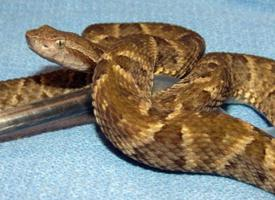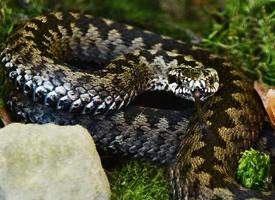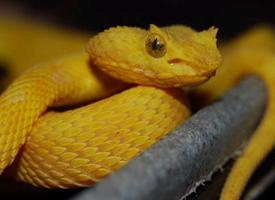
Poids et mesures
| Longueur | 150 cm |
|---|
Données biologiques
| Nombre de petits | 15 - 30 |
|---|
Description de l'animal
The Common Lancehead (Bothrops atrox), also known as the fer-de-lance, barba amarilla, or simply the lancehead, is a highly venomous pit viper species indigenous to the tropical lowlands of northern South America. This formidable serpent is a member of the Viperidae family, which is characterized by their long, hinged fangs that allow them to deliver deep, efficient envenomations. Bothrops atrox plays a significant role in the biodiversity of its habitat but is also notorious for being one of the leading causes of snakebite incidents within its range.Description and Physical Characteristics
The Common Lancehead typically measures between 50 to 125 cm (20 to 49 inches) in length, though individuals exceeding these dimensions have been recorded. The species exhibits sexual dimorphism, with females generally growing larger than males. The snake's robust body is covered in keeled scales that give it a somewhat rough appearance. Its coloration can vary widely from shades of brown and olive to more grayish tones, usually patterned with dark dorsal blotches that allow it to blend seamlessly into the forest floor and leaf litter of its environment.
The head is distinctively shaped, broad, and triangular, a common trait among vipers, which aids in the distinction of this species from non-venomous snakes in its habitat. This shape is further accentuated by the presence of a deep pit located between the eye and the nostril on each side of the head. These pits are highly sensitive to changes in temperature, enabling the lancehead to detect warm-blooded prey even in complete darkness.
Habitat and Distribution
Bothrops atrox is found across a wide range of lowland habitats from the Amazon Basin, encompassing countries such as Brazil, Colombia, Venezuela, Ecuador, Peru, and the Guianas. Its habitat includes tropical rainforests, savannas, and areas of human disturbance such as plantations and the peripheries of urban areas. The species' adaptability to altered landscapes has contributed to its notoriety, as it often comes into contact with human populations.
Behavior and Ecology
The Common Lancehead is primarily nocturnal, spending the day hidden under the leaf litter or within crevices in the ground. At night, it becomes an active hunter, preying on a variety of small mammals, birds, and occasionally amphibians. Its venom, a potent cocktail of hemotoxins, cytotoxins, and neurotoxins, is capable of causing severe tissue damage, bleeding, and disruption of blood clotting in its victims, leading to rapid incapacitation and digestion of the prey.
Reproduction
Bothrops atrox is ovoviviparous, meaning it gives birth to live young rather than laying eggs. A single litter can contain anywhere from a few to over 60 neonates, depending on the size and condition of the mother. The young are born fully formed and capable of fending for themselves, including envenomating prey with a potent bite from birth.
Conservation Status
Currently, the Common Lancehead is not considered to be at risk of extinction and is classified as of Least Concern by the International Union for Conservation of Nature (IUCN). Its wide distribution and generalist habits have allowed it to thrive in many areas, even those heavily impacted by human activities. However, like all wild species, it faces threats from habitat destruction and degradation.
Human Interactions
Bothrops atrox is responsible for a significant number of snakebite incidents in its range, due to its potent venom and tendency to inhabit areas frequented by humans. While antivenom is effective in treating bites, access to medical care can be limited in some of the rural areas where encounters are most common. Education on snakebite prevention and treatment remains a critical component of public health in regions inhabited by the Common Lancehead.
In summary, the Common Lancehead (Bothrops atrox) is a fascinating yet formidable species whose ecological role as a predator contributes to the balance of its ecosystem. While its venom poses a significant risk to humans, understanding and respecting this species' behavior and habitat can reduce negative encounters, highlighting the importance of coexistence with the natural world.
Animaux similaires
Nouvelles photos d'animaux
Top 10 des animaux
- Dolphin gull (Leucophaeus scoresbii)
- Diana monkey (Cercopithecus diana)
- Moustached guenon (Cercopithecus cephus)
- Galápagos tortoise (Geochelone nigra complex)
- Japanese macaque (Macaca fuscata)
- Stone loach (Barbatula barbatula)
- Russian tortoise (Testudo horsfieldii)
- Greek tortoise (Testudo graeca)
- Common flying dragon (Draco volans)
- Vendace (Coregonus albula)


